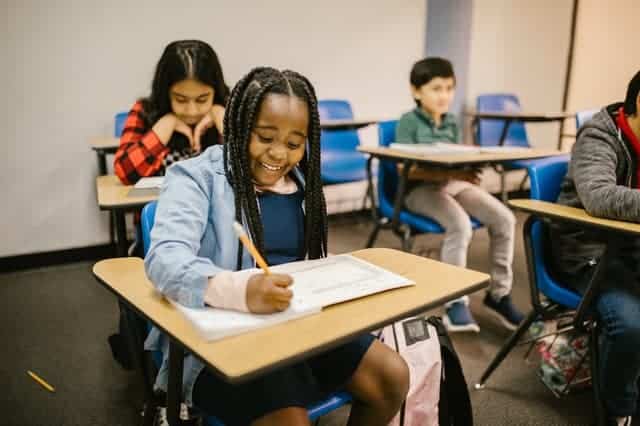Students can quickly become overwhelmed when they have a lot of work to do but haven’t yet been equipped with the skill of goal setting. Overwhelmed students may act as though they are disinterested, aloof, or even lazy. They may appear to engage in an approach-avoidance cycle that adults interpret as a lack of motivation when the reality is that they aren’t sure how their present assignments will lead them to achieve their future goals.
Goal setting for students is vital. Every child needs to be equipped with a clear objective, as well as tactics to help them achieve their objectives when obstacles arise.
This article will discuss the importance of goal setting for students and practical ways to teach it.
Goal Setting for Students
The Importance of Goal Setting
EducationWeek states, “Goal setting helps students to be more aware of the learning that they are expected to experience. This awareness helps students to be engaged in the learning process. Mastery-oriented goals give students the opportunity to focus on learning standards and their own growth.”
As indicated above, there is a strong connection between a student’s understanding of their trajectory in the classroom and their ability to self-assess their learning progress.
For example, most teachers clearly define the student objective inherent within any given lesson plan. Most lesson plans begin with the words, “At the end of this lesson the students will be able to . . . “ Or some such similar statement. Clearly defining the objective of the lesson helps guide the teacher in their planning.
Why not share the objective of your lesson with the students?
Research shows that when you write the day’s objective on the board for all the students to see, they learn how to compare and contrast the day’s goals with their own experience. If a teacher writes, “At the end of this lesson, the students will be able to list the elements of a structured essay,” you are giving clear instructions as well as setting clear goals for your students. Students can, in turn, learn what goal setting looks like and how to measure their progress.
When objectives are social emotional rather than task-based, the objective may sometimes go unspoken. When implementing activities related to social-emotional learning, sharing goals is important. In addition, creating a chart of classroom goals together can help students see what outcomes the classroom wants to achieve while taking an active role in deciding the desired outcome. In this case, the class may come up with ideas like “be respectful to others.” Because the goal is their own and not just given to them, they may take a more active role in ensuring that outcome.
The importance of goal setting for students is that they learn to recognize a goal and outcome so they can eventually create roadmaps for themselves in any area of their lives.
Practical Ways You Can Teach Goal Setting for Students

Goal Setting for Older Students
One of the most widely accepted and practical approaches to goal setting for students is found in the acronym SMART.
Smart goals for students include the following tenants:
- Specific
- Measurable
- Attainable
- Relevant
- Time-based
Let’s get more specific about how to set a smart goal.
Specific
The career search website Indeed discusses smart goals at length. Indeed explains, “By setting objectives and creating a clear roadmap for how you’ll reach your intended target, you can decide how to apply your time and resources to make progress.” This sentiment is a good reminder that what we teach our students about setting goals will follow them into their adulthood and careers.
When you are teaching smart goals for students, you can begin with helping them understand what it means to make a specific goal. The guidelines for setting a specific goal include the 3 S’s:
Simple. Sensible. Significant.
For example, if a student struggles with the concept of long division in math class, they might make a specific goal to help focus their efforts and feel motivated to achieve it. In this case, the student might decide they want to become better at long division because they want to master the skill to move onto the next level of math.
Measurable
Measurable goals help students track their progress and stay focused.
Using the example above, the student might set a goal to practice long division for 20 minutes a day. This is a measurable goal because it includes a specific amount of time and defines a piece of evidence that can prove progress.
Attainable
Setting attainable goals means the goal should stretch your student’s abilities but remain possible.
An attainable goal for a student who wants to become better at long division might be to get a better grade on their next math quiz. So, a student who earned a 60% on one quiz might set the goal of achieving a 70% on their next quiz. This goal is attainable because it is realistic and not overwhelming.
Relevant
Relevant goals are those that matter to your students. Part of the importance of goal setting for students is that they learn to recognize which tasks are essential to spend time on and which are not as relevant to their future endeavors.
Your students’ goals should align with their values and larger, long-term goals. In the example of a student who is struggling with long division, you might encourage them to think about how mastering the skill of long division will help them move on to the next level of math, which will, in turn, help them achieve the goal of graduation to the next grade level.
Connecting tasks to specific outcomes that relate directly to a student’s vision for their future works as a motivator and a source of inspiration!
Time-Based
Setting a clear and specific end-time or end-date for each goal helps students maintain stamina and focus because they know there is an end in sight–especially when they’re working on something they might not be interested in.
The math student might decide, “To achieve my goal of mastering the skill of long division, I will practice these math skills every day for 20 minutes until the next math quiz. Then, I will reassess the amount of time I spend practicing math.”
Short-term goals can help students keep the end in sight, and they also give you, as the teacher or parent, an opportunity to reward their efforts. If they achieve their goal of earning a 10% higher grade on the following math quiz, you can celebrate their success, thus motivating them further. If they don’t achieve their goal, you can celebrate the work they put in and help them reassess their strategies.
Students must learn early on that not reaching a goal the first time is a natural part of learning and growth. Celebrating their determination is just as important as celebrating their victories.
Goal Setting for Younger Students

Goal setting for younger students often needs a more hands-on approach and more practice. In this case the SMART acronym will need to be broken down further. Younger students will need regular instruction on how to set effective goals. Here’s how to break down SMART goals for younger students:
Specific: What exactly do you want to accomplish?
Measurable: How will you know when your goal is set?
Attainable: Is it possible to meet this goal?
Relevant: Is the goal worth your work and effort?
Timely: What is the deadline you want to set to achieve your goal?
To help younger students understand concepts of specific, measurable, attainable, relevant, and timely, it’s helpful for them to explore opposites. For example, “What is specific versus vague,” or “What is measurable versus non-measurable.” This activity can help them better understand the meaning and importance of each term.
Conclusion
Actively having your students participate in classroom goals, having them set specific goals for their tasks, and leading by example are all great ways to introduce goal setting into the classroom. Implementing SMART goals is also helpful because it gives students a framework that is easy to remember and repeat.
At Soul Shoppe, our mission is to transform schools and communities by cultivating awareness, empathy, and connection. Soul Shoppe transforms learning communities into inclusive, empathy–based environments by teaching kids and adults the social–emotional skills they need to navigate life’s difficulties with compassion and self–awareness. From the Peacemakers program to online elementary school SEL programs, and parent programs, Soul Shoppe brings social emotional programs directly to you.
Reach out to us for more information on supporting you as you support our kids and communities!
You Might Also Like:
Conflict Resolution Games for Kids
Virtual Social Emotional Learning Activities


